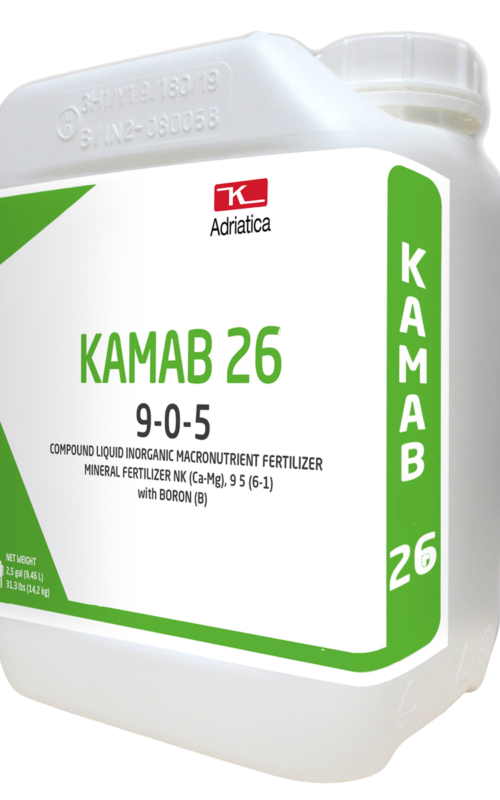Kamab 26
KAMAB 26 the Preferred Product to Correct Plant Physiological Disorders
KAMAB 26, is the preferred product for growers to correct plant physiological disorders attributed to calcium, magnesium and potassium imbalances, including stem necrosis, apical rot, tip burn, bitter bit, and fruit cracking in table grapes, and many other fruit and vegetable crops.
Improved texture and shelf life
Use of KAMAB 26 in initial fruit-growing phases also leads to improved fruit texture and longer shelf life. This occurs because KAMAB 26’s formulation favors the production of calcium pectate, which is the calcium inside cell walls that bound the pectin of two cell walls together, says Mrs. Maria Rosaria Stile, Ph.D., K-Adriatica Research and Development Manager.
“The elements the product supplies in this special technology are in optimal ratio and allow plants to uptake them easily and immediately. The product allows growers to deal with all the physiological disorders that unbalanced nutrition related to calcium, magnesium, and potassium can create in crops," explains Mrs. Stile.
KAMAB 26 Can Improve Fruit Robustness, Color and Aroma
“In a highly competitive market where growers face competition coming from producers who can rely on low-cost production means, the only way to compete and achieve market trust is to produce high-quality products, which is what KAMAB 26 can offer,” explains Mrs. Maria Rosaria Stile, Ph.D., K-Adriatica Research and Development Manager.
Usage Rates
Usage rates of KAMAB 26 differ among crops. For a preventative application in table grapes to combat stem necrosis and grape berry drop, growers should make 3-4 applications from fruit set to veraison. If needed, another application should be made 10-15 days before harvest or upon occurrence of predisposing conditions.
Curative applications should be made at the appearance of the first symptoms and should be repeated every 7-10 days until the symptoms disappear.
“The elements the product supplies in this special technology are in optimal ratio and allow plants to uptake them easily and immediately,” Stiles says. “The product allows growers to deal with all the physiological disorders that unbalanced nutrition related to calcium, magnesium, and potassium can create in crops.”

Following Is a Sampling of Crops That Will Benefit From KAMAB 26
Grapes
bitter pit, post-harvest rotting, superficial scald
pome fruits
(apple, pear quince)
bitter pit, post-harvest rotting and superficial scald
Stone fruit
(apricot, cherry, nectarine, peach, plum)
flesh browning, superficial scald and shelf life
strawberries
tip burn, calix necrosis and shelf life
mango-avocado
flower drop and fruit drop
small fruits
(raspberry, blueberry, blackberry, currant)
fruit softening and shelf life
fruiting vegetables
(watermelon, cucumber, eggplant, melon, pepper, tomato, zucchini, pumpkin)
apical rot
leafy vegetables
(chicory, lettuce, radicchio, rocket, escarole, celery, spinach)
tip burn
KAMAB 26 Is the Preferred Product
KAMAB 26, is the preferred product for growers to correct plant physiological disorders attributed to calcium, magnesium and potassium imbalances, including stem necrosis, apical rot, tip burn, bitter bit, and fruit cracking in table grapes and many other fruit and vegetable crops.
A foliar fertilizer, KAMAB 26 was initially developed in the 1980s for Chilean table grape farmers, whose crops had contracted stem necrosis, a physiological disorder of grapevines. The disorder causes grape clusters to wither and die on vines during ripening.
“It was a major problem, but KAMAB 26 proved to be very effective for Chilean agriculture’s table grape production,” says Mrs. Maria Rosaria Stile, Ph.D., K-Adriatica’s Research and Development Manager.
Why Kamab 26 Is Preferred
Improves texture and shelf life
Regulates nitrogen absorption processes
Limits ammonium accumulation in plant tissues
Neutralizes organic acids that are in excess
Enhances resistance to Botrytis cinerea in table grapes and vegetables
Application Recommendations
Click the tab to learn more
Grapes
Grapes
Nutritional disorder
Stem necrosis, grape berry drop
Application Time
Preventative: 3-4 applications from fruit set to veralson (change of color); if needed, repeat the application 10-15 days before harvesting or upon the occurrence of predisposing conditions.
Curative: at the appearance of the first symptoms; to be repeated every 7-10 days until the symptoms disappear
Dose/Acre*/Application
37 fl oz - 55 fl oz
Pome fruits (apple, pear, quince)
Pome fruits (apple, pear, quince)
Nutritional disorder
Bitter pit, post-harvest rotting, superficial scald
Application Time
2-3 applications every 10-12 days, from fruit set to fruit diameter up to 40 mm
Dose/Acre*/Application
37 fl oz - 55 fl oz
Kiwifruit
Kiwifruit
Nutritional disorder
Fruit softening, shelf-life
Application Time
3-4 applications every 10-12 days, from flowering to fruit diameter up to 40 mm
Dose/Acre*/Application
37 fl oz - 55 fl oz
Stone fruits (peach, nectarine, apricot, cherry, plum)
Stone fruits (peach, nectarine, apricot, cherry, plum)
Nutritional disorder
Internal flesh browning, superficial scald, shelf-life
Application Time
2-3 applications, from fruit-set to veraison (change of color)
Dose/Acre*/Application
37 fl oz - 55 fl oz
Strawberries
Strawberries
Nutritional disorder
Tip burn, calix necrosis, shelf-life
Application Time
2-3 applications from fruit-set, every 10-12 days
Dose/Acre*/Application
37 fl oz - 55 fl oz
Mango, avocado
Mango, avocado
Nutritional disorder
Flower drop, fruit drop
Application Time
3-4 applications before flowering, beginning of flowering, full flowering, when fruits are at 10% of the final dimension
Dose/Acre*/Application
37 fl oz - 55 fl oz
Small fruits (blueberry, raspberry, blackberry, currant)
Small fruits (blueberry, raspberry, blackberry, currant)
Nutritional disorder
Internal flesh browning, superficial scald, shelf-life
Application Time
3-4 applications, from pre-flowering every 10-12 days
Dose/Acre*/Application
37 fl oz - 55 fl oz
Fruiting vegetables (tomato, pepper, eggplant, melon, watermelon, cucumber, zucchini, pumpkin)
Fruiting vegetables (tomato, pepper, eggplant, melon, watermelon, cucumber, zucchini, pumpkin)
Nutritional disorder
Apical rot
Application Time
2-3 applications, from pre-flowering every 10-15 days
Dose/Acre*/Application
37 fl oz - 55 fl oz
Leafy vegetables (lettuce, escarole, chicory, radicchio, rocket, celery, spinach, broccoli)
Leafy vegetables (lettuce, escarole, chicory, radicchio, rocket, celery, spinach, broccoli)
Nutritional disorder
Tip burn
Application Time
3 applications:
1° application: 7 days after transplanting
2° application: 7-10 days after the previous one
3° application: 8 days before harvest
Dose/Acre*/Application
37 fl oz - 55 fl oz
All crops
All crops
Nutritional disorder
Fruit texture, shelf-life, fruit cracking
Application Time
2-3 applications, every 10-12 days, from fruit-set to fruit diameter up to 40 mm
Dose/Acre*/Application
37 fl oz - 55 fl oz
*The choice of the dose is subordinated to various factors and can be varied when necessary. All applications can be repeated in relation to the different crop needs. You can contact our Technical Service for the correct application on specific soils and under specific climate conditions.
